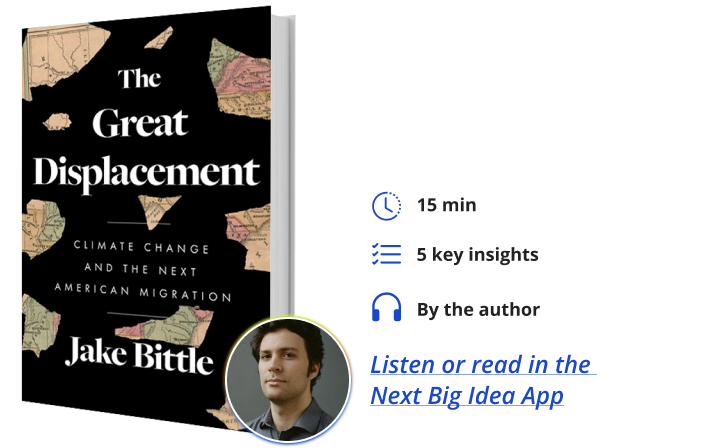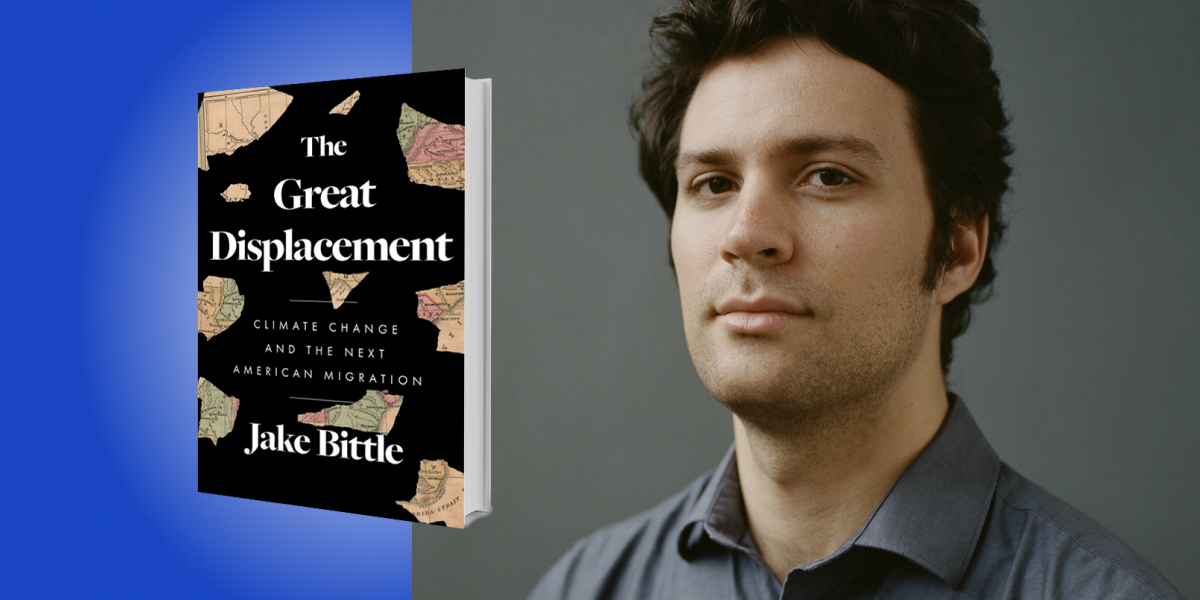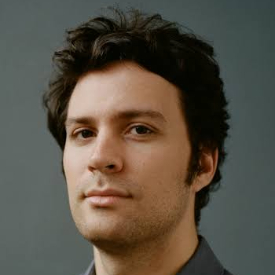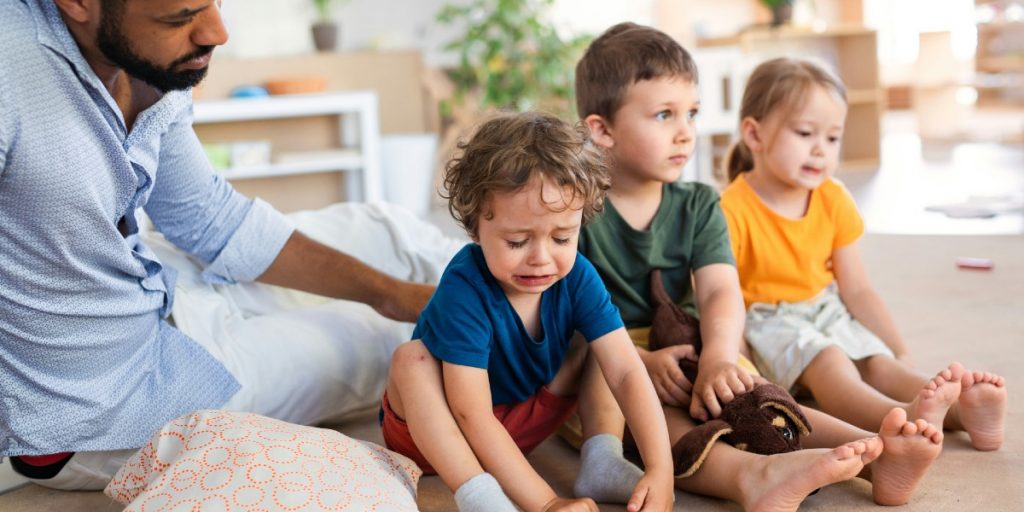Jake Bittle is a staff writer at Grist, where he covers climate change and energy. His work has also appeared in The New York Times, The Guardian, and Harper’s Magazine.
Below, Jake shares five key insights from his new book, The Great Displacement: Climate Change and the Next American Migration. Listen to the audio version—read by Jake himself—in the Next Big Idea App.

1. Climate change is already here.
A lot of people in the United States see climate change as something to be talked about mostly in the future tense. It may happen, or maybe it’s already happening in other parts of the world, but not so much here in the United States. But that’s pretty much wrong. Tens of thousands of people lose their homes to climate disasters in the United States every year, and a substantial portion of those people never make it back to the original homes that they occupied before the disasters.
Climate change disasters, such as droughts and sea level rise, are also revising the way local economies work, making it impossible for people to continue with the jobs that they had had or to live in places that were once affordable. So, it’s making things more expensive, more difficult, and altogether dicier in many of the most vulnerable parts of the country.
A lot of this motion is hard to recognize, or it’s hardly talked about in mainstream media, because most coverage of climate disasters focuses on the immediate impacts of a hurricane or a wildfire, but doesn’t follow the yearslong process of recovery and relocation after the fact. My goal is to shine a light on the long and turbulent process that follows these disasters and show the implications for how we understand concepts like home or upward mobility or stability, to show how climate change unsettles big concepts and what it means to live in a certain place for one’s entire life.
2. Our disaster relief system is broken.
The way the United States responds to climate disasters doesn’t work. Many people are familiar with the main federal disaster agency, FEMA (Federal Emergency Management Agency), and they basically know that the point of FEMA is to help places rebuild after a disaster. There are a lot of things wrong with this. The first part is that FEMA is underfunded and understaffed, and it lacks the resources to help a community that gets hit by a hurricane or wildfire recover back to its original state.
“The problem is that a lot of these communities never should have been built the way that they were built in the first place.”
The second problem is that FEMA is very rigid and has outdated practices. The way it responds to most disasters is basically to rebuild the community, exactly the way it was, to whatever extent that it can. The problem is that a lot of these communities along the Gulf of Mexico or in the mountainous parts of California never should have been built the way that they were built in the first place. They’re extremely vulnerable to sea level rise, wildfire, drought stresses, and big storms. By rebuilding all the infrastructure the way that it was before, it’s just going to get destroyed again. This has happened in a lot of flood-prone parts of the country, as FEMA has paid to rebuild the same homes upwards of seven or eight times in some cases. They’re overdue for a revamp, and as things stand, places that get perennially hit by the same disasters will gradually disintegrate.
Some parts of North Carolina that are prone to flooding, or places in coastal Louisiana, get hit over and over again. The federal government doesn’t do a good job of taming the risk in those places so that they become more resilient to those disasters. Maybe they could build flood walls, or move the towns back from the river, but they don’t do that. Instead, they rebuild things as they were, and that’s a big reason for a lot of recurring suffering and destitution.
3. We’ve built in risky areas.
A lot of the places with the most displacement and devastation from climate change are places where we’ve engaged in very risky construction, having built in places where we shouldn’t have. Many towns that have been devastated by flooding are ones where we built thousands of homes in what FEMA classified as perennially vulnerable flood zones. Many of the towns that have burned down in wildfires were built in the wildland urban interface, meaning a part of the forest that is destined to burn as part of the natural life cycle of forest regeneration. This is especially true in the American Southwest, where a lot of the biggest cities, like Phoenix and Tucson, were built thanks to extremely audacious water infrastructure that moves water from extremely faraway places so that people can live there and irrigate agriculture. But now they’re running short on water thanks to drought, and their infrastructure is not working anymore.
“It’s also about certain vulnerabilities that have been there the whole time, certain cracks that are getting wider as climate change puts extra stress on an already fragile society.”
An important part of discussing climate change is discussing the kind of society that climate disasters impact. It’s not just about nature getting more devastating. It’s also about certain vulnerabilities that have been there the whole time, certain cracks that are getting wider as climate change puts extra stress on an already fragile society. In many cities or rural areas with shoddy infrastructure, or places where we should not have pushed development, which have suffered a big climate disaster, you can almost always find a really bad development decision in its history. You can’t discuss climate change in isolation from the societies impacted by it.
4. Migration doesn’t look like we think.
When we think of climate migration, a lot of us think of a person, perhaps on the other side of the world, who intentionally chooses to escape climate disaster by moving far away to more temperate places. But it really doesn’t look like this in the United States, or anywhere. Most movements are involuntary and driven not by somebody’s psychological desire to avoid climate disasters, but usually, it just becomes too expensive to live there, or they can’t afford to rebuild their home. A lot of people in the places experiencing the greatest levels of displacement are extremely attached to the homes that they are leaving behind. They don’t want to move, and when they do, they move relatively short distances. They don’t usually move one time either. Disaster inaugurates this process of relocation in which they rebuild and then move again or move back. After some time, maybe they leave again. It’s never as simple as moving from point A to point B.
When discussing this emerging term of climate migration, it’s important to remember that migration isn’t always intentional. It’s not always purposeful. It’s usually agonizing. It’s also not something that ends quickly—it can go on for years. Often, somebody’s moving right back to the place that they lived before, especially because the government doesn’t encourage people to live in less risky places. It’s not like an arrow shooting from bow to target. It’s more like a churning pot or a cauldron because it reaches a boiling point and things start to move around, swirl, and it’s chaotic. In the aftermath of natural disaster, you can see this happen: people move in seemingly random ways. It takes a while for a pattern of long-term regional relocation to emerge.
“A lot of people in the places experiencing the greatest levels of displacement are extremely attached to the homes that they are leaving behind.”
In terms of long-term movement from the south, or from the driest places, up to the more temperate places, we won’t see that for a few decades. For the next few decades, we will just see this constant collision and relocation as people seek safe and affordable homes as close as possible to their existing social ties.
5. Climate change will force us to rethink ideas about home.
Homeownership, for many people in the American middle class, has been the anchor of their wealth and their central path to economic advancement. Your home is your biggest investment, it’s worth more than basically everything else that you own combined. You’re supposed to be able to keep that home and sell it for more money later. But as climate change gets more severe, a lot of people are losing those investments due to disaster or if they can no longer afford rising costs, such as insurance and mortgage loans. That picture of middle-class stability, which was already inaccessible for many people in this country, is going to become even more inaccessible. People, especially in places like Miami or the Gulf, will be driven out into this purgatory of renting or living with family after disasters, and will never make it back to middle-class stability.
Climate change is also going to force us to rethink the idea of home. Most people that I spoke to lived in one place for their whole lives and never thought that they’d leave. After a disaster, they had to let go of those places. I think a lot of people in the United States define themselves based on where they live or where they grew up. A lot of people are going to have to let go of the places that they most strongly identify with because the costs of rebuilding and maintaining them are just going to be too high. That’s going to cause not only economic pain but psychological and emotional pain for people in the coming decades.
To listen to the audio version read by author Jake Bittle, download the Next Big Idea App today:
































